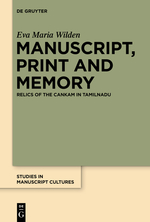SMC 3

Manuscript, Print and Memory:
Relics of the Cankam in Tamilnadu
By Eva Maria Wilden
The ancient Tamil poetic corpus of the Cankam ("The Academy") is a national treasure for Tamilians and a battle-ground for linguists and historians of politics, culture and literature. Going back to oral predecessors probably dating back to the beginning of the first millennium, it has had an extremely rich and variegated history. Collected into anthologies and endowed with literary theories and voluminous commentaries, it became the centre-piece of the Tamil literary canon, associated with the royal court of the Pandya dynasty in Madurai. Its decline began in the late middle ages, and by the late 17th century it had fallen into near oblivion, before being rediscovered at the beginning of the print era. The present study traces the complex historical process of its transmission over some 2000 years, using and documenting a wide range of sources, in particular surviving manuscripts, the early prints, the commentaries of the literary and grammatical traditions and a vast range of later literature that creates a web of inter-textual references and quotations.
Contents
Frontmatter, Acknowledgements
Prefacevii
List of Abbreviationix
I Introduction1
1 Sources, Methods and Aims1
2 The Corpus6
2.1 Its Constitution6
2.2 Its Fate15
3 Research History and Programme26
3.1 The Tamil Renaissance 27
3.2 Tamil Manuscripts 35
II The Manuscripts42
1 Surviving Caṅkam Manuscripts: Descriptive Catalogue42
1.1 Libraries of Origin43
1.2 Manuscript list44
1.3 Manuscript Catalogue50
1.3.1 Eṭṭuttokai50
1.3.2 Pattuppāṭṭu74
2 Manuscripts Reported in Catalogues and Editions87
2.1 Catalogues88
2.2 Manuscript Descriptions in the Editions99
3 Colophons and Library Information122
3.1 List of Available Colophons123
3.1.1 Eṭṭuttokai123
3.1.2 Pattuppāṭṭu125
3.2 Scribal Colophons and/or Information on Title Pages 128
3.2.1 Eṭṭuttokai128
3.2.2 Pattuppāṭṭu133
3.2.3 Information from Scribal Colophons and Title Pages134
4 Summary: Age and Distribution of the Remaining Witnesses 138
III Transmissional History146
1 The Invocation Stanzas (kaṭavuḷ vāḻttu)146
1.1 Kuṟuntokai 1146
1.2 The Series by Pāratam Pā ṭiya Peruntēvaṉār149
2 Traditional Colophons160
2.1 Eṭṭuttokai161
2.2 Pattuppāṭṭu166
2.3 Information from the Traditional Colophons 175
3 Mnemonic Stanzas 177
3.1 Eṭṭuttokai (14 verses)179
3.2 Pattuppāṭṭu (19 plus 12 verses198
4 The Caṅkam Legends 216
4.1 Introduction216
4.2 The Preamble to Nakkīra? and Its Late Metrical Echo 218
4.2.1. Two Floods and Three Academies 218
4.2.2 The Academy on the Ganges 223
4.2.3 Two Floods and Three Academies in Verse 225
4.2.4 A Drought, a Poetic Manual, and a Commentary 229
4.3 Academicians Infiltrating the Śaiva Canon 235
4.3.1 The Tirumuṟai237
4.3.2 The First Synthesis: Kallāṭam241
4.4 Śiva's Sports in Maturai247
4.4.1 Nampi's Tiruviḷaiyāṭaṟpurāṇam256
4.4.2 Hālāsya Mahātmya263
4.4.3 Paranñōcoti's Tiruviḷaiyāṭaṟpurāṇam268
4.4.4 Śivalīlārṇava270
4.4.5 Cīkāḷatti Purāṇam271
4.5 The Tiruvaḷḷuvar Branch274
4.5.1 Kallāṭam and Tiruvaḷḷuva Mālai275
4.5.2 The 19th-Century reports279
4.6 Legend Merging into “History”285
4.6.1 The Beginnings of Literary Historiography285
4.6.2 The Proto-History of Tamilnadu: Lemuria292
5 Reception in the Grammatical Tradition295
5.1 The Legend Reflected in the Commentaries296
5.2 The Corpus Reflected in the Commentaries307
5.2.Appendix 1: Tables of Quotations from the Poetological Commentaries 318
5.2.Appendix 2: The Distribution of Quoted Poems in Poetological Commentaries323
5.2.Appendix 3: The Distribution of Quoted Poems in Grammatical Commentaries330
5.3 Glimpses from Discussions of Literature345
Coda: The Maturaic Cokkanātar Aruḷiya Tamiḻ Viṭutūtu351
6 Summary: The Rise and Fall of a Canon354
IV The Editing Process359
1 Notes on the Development of the Tamil Script362
2 The Path from Palm-Leaves to Paper to Printed Editions367
3 The Early Caṅkam Editions386
4 Case Studies: The Kuṟuntokai, the Naṟṟiṇai and the Akanāṉūṟu390
5 Later Caṅkam Editions404
5 Appendix: Manuscripts Containing Exegetical Material406
6 Summary: Decipherment, Standardisation, Popularisation409
V Conclusion: The Restitution of a Canon412
Literature418
List of Acknowledgements for the Illustrations433
Index434
